Association football
![]()
The title of this article is ambiguous. For other meanings, see Football (disambiguation).
Football is a ball sport in which two teams compete against each other with the aim of scoring more goals than their opponents and thus winning the match. The game is usually played for two periods of 45 minutes, plus injury time and, if necessary, extra time and/or penalties. A team usually consists of eleven players, one of whom is the goalkeeper. The ball may be played with the whole body except the arms and hands; it is mainly kicked with the foot. Only the goalkeeper (inside his own penalty area) - or the field players when taking a throw-in - may touch the ball with his hands.
The success of football is based, firstly, on its simplicity. The cost of resources and equipment is relatively low (see, for example, street football), which has also made it very popular in many developing countries, and it is easy for newcomers and spectators to understand or even take for granted. Secondly, there are comparatively few goals scored, which increases the value of a goal and makes the games more exciting, as superior or better-placed teams cannot win as often or be determined as winners early on as in other ball sports. However, these special features have been counteracted in recent times by more complicated regulations (e.g. changes to the offside rule) and, in top-level football, ever greater (technical) expenditure (e.g. video evidence), which are intended to lead to "fairer" football.
Football originated in Britain in the second half of the 19th century and spread to continental Europe and other continents from the 1880s and 1890s. It is considered the world's most popular team sport. Unlike other sports (such as handball), top clubs in football usually developed only in large cities, which can boast the very elaborate infrastructure with recently increasing demands.
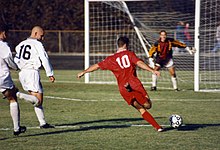
Soccer scene
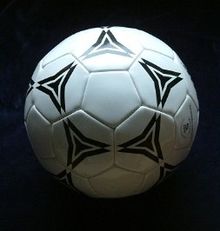
A football
History
→ Main article: History of football
Early forms of play
In the second millennium BC, a football-like game called Cuju (Ts'u-chü) ("cu" = to push with the foot; "ju" = ball) was played in China. Nothing is known about the rules of the game at that time. However, it is considered certain that it was conducted as a military training program to train soldiers. In the course of the Zhou dynasty, the sporting game spread among the people, and an attempt was made to limit violence and rowdiness by means of rules. The ball was made of leather pieces sewn together and stuffed with feathers and animal hair. In the Qin to Sui dynasties, the game of soccer grew in popularity. Between the years 220 and 680, the air-filled ball was invented and football rules (goals, goalkeepers and captains) were recorded for the first time. About 100 years later, however, the game fell into oblivion again.
Images of ball games on reliefs and vases have survived from the cultural sphere of ancient Greece, primarily from Sparta, where physical training was highly valued. The Romans of antiquity also knew ball sports, which, like the Chinese Cuju, were played in a military context.
The Turkish scholar Mahmud al-Kajgharī describes in his book dīwān lughāt at-turk that in the 11th century among the Turkic peoples living in the Central Asian region a game called tepük (Old Turkic for: kick or footstep) enjoyed great popularity.
In the early Middle Ages in England, an early type of today's football game was practiced in which inhabitants of two towns tried to get a ball through the opposing town gate. The "playing field" was always between two towns, even if they were several miles apart.
With the discovery of America, Europeans came into contact with the ancient ball games of Central America, which had a long tradition across different cultures, sometimes had a religious or judicial function, and were played in fortified stadiums.
Even though England is considered the "mother country of football", there were also fighting games in France and Italy that were already related to the game of shooters. Since the 15th century, the Calcio Storico has been practiced in Florence, a kind of football game in which things can get quite rough. Scaino wrote in 1555:
"The runner who runs through the field with the ball in his hand should be given space by those who are strong enough so that their man has free passage without hindrance. But if he sees himself attacked by a large crowd, he shall slacken his pace and ... push the ball, and he will be able to do this more quickly with the push of the foot than in any other way, since a push in this way is safer. “
However, Scaino also specified the size of the pitch (the church square in front of Santa Croce (Florence) = about 100 × 50 m), determined that goals decide (and not the beautiful game or the particularly beautiful outfit) and that the game is excluded from normal life (subordination relations of real life do not apply on the pitch, i.e. the master cannot order the servant to give him the ball).
The roots of football in the 19th century
In 1848, students at Cambridge University wrote the first football rules. After that, a team consisted of 15 to 20 players. In 1857, cricketers founded Sheffield FC, the world's first official football club. England is therefore considered the "motherland of football", not least because it was here that the Football Association (FA), founded in London in 1863, was formed, a comprehensive set of rules was created and the development of the sport was sustainably promoted.
The term soccer as the English name for football is derived from the term association football for the sport, which was coined as a contrast to rugby, in the sense of playing football according to the rules of the Football Association.
In 1866 the offside rule was introduced, and in the Sheffield Code the rules were extended to include the corner kick and the free kick. In 1870, the FA limited the number of players to eleven. A year later, the English Football Association banned all field players from playing with their hands; only the goalkeeper was still allowed to play the ball with his hand in his own half, but had to release it after two steps. In 1872, a uniform ball size was established. With these rules, the game of football was increasingly differentiated from rugby, which was much more widespread at the time.
In 1872, the first official international match was played in Glasgow between Scotland and England (final score 0-0). The same year saw the introduction of the FA Cup, the first national football competition, and two years later the football referee, who officiated the match.
In 1878 the first match under electric lighting (by so-called floodlights) took place in Sheffield at Bramall Lane. One year later the first professional league in England was founded (first champion was Preston North End). In 1891, penalty kicks were introduced into the regulations in Ireland. Since 1897, a deciding match could be extended in the event of a draw. Two years later, the English FA allowed paid club transfers in England, but initially only at a maximum of ten pounds.
In continental Europe, football first became established in Switzerland. In the Lake Geneva region, Englishmen studying at private schools there introduced football from around 1855. The oldest club still in existence, FC St. Gallen, also founded by English students in 1879, subsequently played a central role in administrative matters relating to football. From Switzerland, football was exported to surrounding countries. Stade Helvétique Marseille, founded by Swiss, became French champions in 1909; the team consisted of 10 Swiss and one Englishman. FC Barcelona, in turn, was founded by the Swiss Joan Gamper.
In 1895, eleven Swiss clubs, including university teams made up of British players, formed the Swiss Football Association. The first Swiss championship was held in the 1897/1898 season under the sponsorship of La Suisse Sportive, a French sports newspaper.
In Germany, the game of football was still in its infancy at the time. It was first introduced by the grammar school teacher Konrad Koch in 1874 at the Martino-Katharineum in Braunschweig. Koch himself was a supporter of rugby throughout his life. His biographer Malte Oberschelp stresses that Koch did not introduce football to Germany, but rugby. That is why he had his pupils play this variant of football with picking up the ball with their hands. In the western Rhineland, resident English merchants and industrialists brought the "sport of football" into the country alongside the traditional equestrian sport. It had to struggle for social recognition here for much longer than in the mother country England, because until the 20th century German physical training and education was synonymous with gymnastics, which had been firmly anchored in schools and the military since the foundation of the German Reich in 1871. The team sport imported from England was a new and modern form of physical culture in the German Empire.
For a long time, the first football club in Germany was considered to be the Dresden English Football Club, which was founded in 1873 by Englishmen living and working in Dresden. However, an English source reveals that although the Dresden Football Club was founded in October 1873, it played according to rugby rules. Football also established itself very early in the Imperial Navy, which was closely aligned with the English model and world political rival. The first evidence of a football match in Germany played according to the rules of the Football Association (FA) comes from Lüneburg and dates from 1875. At the Johanneum there, the teacher Wilhelm Görges and the young Englishman Richard Ernest Newell Twopeny, who had come from Marlborough College, introduced the game of football. Several games are documented, the first of which was reported in the Lüneburgsche Anzeiger in September 1875. However, the club founded at the Johanneum only existed for a short time and then fell into oblivion.
Early clubs were also founded in the vicinity of the old technical universities, for example in Dresden, Karlsruhe, Aachen and Munich. The up-and-coming footballers adopted corporate student customs and songs to their sport, but distanced themselves from the classical fraternity business of the traditional universities as well as from conventional gymnastics. Thus the song line O alte Burschenherrlichkeit became the lyrics O wonnevolles Fußballspiel.
The sport of football in those years was predominantly practiced in bourgeois circles and was considered a fashionable sport of the middle classes as well as of upwardly mobile people, not least of Jewish origin (cf. Kurt Landauer). Workers had neither enough free time nor financial means for the equipment. It was not until the social legislation of the Weimar Republic that football, along with other sports, reached the working classes in the 1920s and thus became a mass phenomenon.
Organised football in the 20th century
In 1900, football was given a higher-level association for the first time in Germany with the founding of the German Football Association (DFB). In the same year, two football matches were played at the Olympic Games in Paris.
On 31 May 1903, the Altonaer Fußballclub von 1893 (Altona 93) hosted the final match for the German football championship between VfB Leipzig and DFC Prague at the Exerzierweide in Bahrenfeld (then a district of Altona).
From 1908 onwards, the military also discovered football and its function of strengthening soldierly group cohesion. The first military teams were formed within the infantry, including the sailors.
On 21 May 1904, a world association, the Fédération Internationale de Football Association (FIFA), was founded in Paris to organise international matches and draw up international football rules, but it also had to align itself closely with the much older English FA and the other British associations. This also resulted in the International Football Association Board, which to this day is made up of representatives of the four British associations and four representatives of FIFA. FIFA defined dangerous play, introduced the direct free kick and removed the requirement for players' trousers to cover their knees. Other new rules from world football's governing body prohibited the goalkeeper from leaving the goal line when taking a penalty kick, but allowed him to move to irritate the shooter. Furthermore, metal insoles in football boots were banned, the ball had to be made of leather, and referees were required to keep a record of the game. In 1907, offside in one's own half of the field was abolished. Two years later, rules on sending off were established. In 1913, FIFA introduced the so-called due distance (10 yards, roughly 9.15 metres) between the kicker and the opponents at free kicks. In 1920, offside at throw-ins was abolished. Since 1924, the corner kick may be taken directly into the goal.
With the introduction of a professional league in 1924, Austria became the first continental European country with a league for professional footballers. Three years later, the Austrian Football Association initiated the Mitropapokal, the first major international competition for club teams in Europe. The Mitropapokal is considered the forerunner of today's European Cup.
Football has been an Olympic discipline since 1900, and in 1920 Egypt became the first non-European nation to participate. With 22 competitors, including the USA and Uruguay, the 1924 Olympic tournament in Paris was the first global competition. The winner was Uruguay, who repeated their Olympic victory in Antwerp in 1928.
In 1930, on the initiative of Enrique Buero and Jules Rimet, FIFA organised the first World Cup, in which the hosts Uruguay became world champions. 13 teams took part in the World Cup, but the German team, like almost all European teams, decided not to travel to South America for reasons of cost.
UEFA, the European football association, was founded in Basel in 1954. UEFA organised the first European Champion Clubs' Cup (now the UEFA Champions League) in 1955/56 and the European Cup of Nations competition from 1960 onwards, which was renamed the European Championship in 1968.
In 1970, the German Football Association allowed women's football in Germany after an increasing number of women's football teams had formed under sometimes creative "cover names".
On 15 December 1995, the so-called "Bosman decision" shook up the usual transfer practice in football. The European Court of Justice ruled that football players are normal employees. Since then, transfer fees can only be demanded for football players if they have a current contract.
After several invitational tournaments in the 1970s and 1980s, the first Women's World Cup was held in 1991, and since 1996 the Olympic champion has also been determined among the women's national teams.
.jpg)
In the 17th century the Calcio Storico, a kind of football, was played in Florence
.jpg)
The first international match (between England and Scotland) took place in 1872 (press drawing)
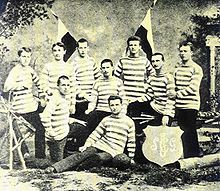
FC St. Gallen in 1881
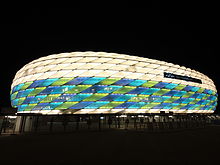
The Allianz Arena in Munich: One of the most modern stadiums in the world, built for the 2006 World Cup
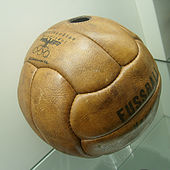
Leather football for competition at the 1936 Olympic Games
Gameplay
Football is played by two teams of eleven players on a rectangular pitch. The aim of the game is to get the ball into the opponent's goal more times than the opponent manages. A goal only counts if the ball completely crosses the goal line between the goal posts and below the crossbar. Football is the name for both the sport and the playing equipment, the football itself.
The goals are located in the middle of the two short sides of the pitch. They are guarded by a special player of the respective team, the goalkeeper, who is also allowed to play the ball with his hands inside the penalty area. The goalkeeper wears special clothing and equipment (goalkeeper gloves) that visually distinguishes him from the other players. The other ten players on each team are called field players and are divided into defensive players, midfielders and strikers.
The winner is the team that scored the most goals during the match. In the event of a tie, the match ends in a draw. An exception is made for matches in so-called knockout rounds, where extra time and/or a penalty shootout may be required to decide the outcome.
Rules
→ Main article: Football rules
Open field play is generally governed by the following rules: The game is played on a rectangular open field. In professional football, a grass pitch is used as the ground surface, less frequently a hard pitch (Tennenfläche) is used, but increasingly artificial turf is used.
The length of the short sides (goal line) should be between 45 and 90 metres, the length of the long sides (touchline) between 90 and 120 metres (the usual length is 68 by 105 metres, these dimensions have been mandatory for international matches since 2008). The pitch is delimited by white lines (usually lime), which may be no more than twelve centimetres wide. The centre line, the kick-off circle and point, the penalty area and penalty spot, the goal area and the four corner circles are also marked.
In the middle of each of the short sides is a gate. It consists of two "posts" connected by a "crossbar". The distance between the inner edges of the posts is 7.32 meters. The bottom edge of the crossbar is 2.44 meters from the ground. The goals are fitted with nets to catch the ball when it has entered the goal. The football shall be in the shape of a ball and made of a suitable material such as leather.
Player equipment for field players and goalkeepers are jersey, socks, shin guards, soccer shoes and shorts. The rules state that a player may not wear jewelry (necklace, wristwatch, ring, earring, or similar) while playing. Glasses are also prohibited unless wearing them is medically absolutely necessary (e.g. Edgar Davids); the same applies to medical protective masks and bandages. The reason for these prohibitions is the increased risk of injury. The ball may be played with the whole body, except the arms and hands. Only the goalkeeper may touch the ball with his arms and hands, but only within his own penalty area and only if the ball has not been deliberately passed back to him by his own team-mate with his foot or knee (back-pass rule). The goalkeeper is also identified by his clothing, which must be clearly distinguishable from the jerseys of the field players and the referee. Outside the penalty area, the goalkeeper behaves like a normal field player. A whistle may not be blown if no player is marked as a goalkeeper. Field players may also play the ball with their hands during a throw-in in order to return the ball to the field of play if it has crossed the touch line. Any other intentional touching of the ball with the hand is prohibited. A hand game is considered "intentional" whenever the player makes a movement with the hand or arm toward the ball. If a hand is shot in a natural position, there is no deliberate handball.
The game normally lasts 90 minutes, divided into two halves of 45 minutes each, with a maximum half-time interval of 15 minutes. However, the actual playing time is usually a few minutes longer, as the referee may extend the playing time by a corresponding "injury time" due to interruptions.
A team consists of ten field players and the goalkeeper. The number of players may be reduced by sending-offs ("red card" or "yellow-red card"). A maximum of three substitutes may be used in competitive matches to replace exhausted or injured players or to make tactical changes. However, players who have already been substituted may not be substituted again. If a team violates one of these rules, the match will be scored 3:0 in favour of the opponent, if the opponent did not win by more than 3:0 anyway. If a team has less than seven players on the field, the game may not be started or continued.
Compliance with the rules is monitored by a referee on the pitch. In higher-class matches, he is assisted by two assistant referees (linesmen) on the long sides of the pitch. In many international matches (World Cup, European Championship, European Cup, UEFA Women's Cup) and in the Bundesliga, there is also another assistant, the so-called "fourth official". His job is to monitor the behaviour of the coaches, support staff and substitutes, to deal with substitutions and substitutions and to indicate injury time. He is also a substitute for the referee. Since the 2006 World Cup, there has also been a fifth official, who is a substitute for the two assistant referees. Since 2010, there have also been two additional "goal judges" for each match in the Europa League and the Champions League, who are supposed to decide whether the ball is completely behind the goal line after a goal kick; technical aids that serve the same purpose are generally not intended to be introduced, but the introduction of balls with microchips to determine the position is being discussed.
If a player breaks the rules, the referee calls a foul. Play is stopped and the opposing team is awarded a free kick or, if the foul was committed inside the penalty area, a penalty kick from the penalty spot. Because of the distance from the goal line to the penalty spot (12 yards = 10.9728 m), the penalty kick is also called a "penalty kick" in common parlance. If the stoppage of play would interrupt a game situation that is advantageous to the aggrieved team, the referee has the discretion to rule "advantage" and allow play to continue. The referee shall award a direct free kick or penalty kick if play has been stopped because of deliberate handball or foul play (involving physical contact). In all other cases, the referee decides on an indirect free kick. A goal can be scored directly from a direct free kick. After an indirect free kick, the ball is not in play until a second player (of any team) has touched the ball and the ball has moved. Therefore, a goal can only be scored if a player of your own or the opposing team touches the ball on its way into the goal.
In addition, the referee may issue a formal warning to the fouling player. This is indicated by the "yellow card". In the event of a serious breach of the rules (e.g. a serious foul), the referee may also send the player off by showing him the red card. A player is also sent off if he receives a second yellow card in a match; this automatically results in a red card, which is why it is also called a "yellow-red card". In particular, fouls or handball should be punished with a sending-off (red card) if they prevent a clear goal-scoring opportunity for the opponent, or if the foul endangers the health of the fouled player or the health of the fouling player is endangered.
The most complicated rule in football is the offside rule. This is a rule that declares certain field positions of attacking players against the defenders of the opposing team to be against the rules, thus stopping the attack on the opponent's goal.
A dropped ball is given when a football match has been stopped without a player on the field having broken the Laws of the Game. For example, if a player is injured without an opponent being involved, the referee can stop the game. The match is then restarted with a dropped ball at the place where it was stopped.
If the pitch is unplayable because of bad weather or for any other reason, so that players are in danger of injury or it is not possible to play the match properly, the referee may cancel the match or stop or suspend it after the whistle. Also, if the floodlights go out in the dark, the game will be suspended. If after a certain time (usually 30 minutes) the fault has not been corrected, the match is cancelled. If there is snow, the game must be played with a colored (usually neon) ball that is clearly visible, and the penalty areas must be marked with eight auxiliary flags or will be cleared. Flags on the edge of the field at the corner flags are mandatory at all times. In foggy conditions, a match is cancelled if the opposing goal cannot be seen from the opposite goal line.
The rules may be modified for games played by women, youth under 16, players over 35 or disabled players. The size of the pitch, the size, weight and material of the ball, the size of the goals, the duration of the match and the number of substitutions may be adapted.
Rule changes are discussed and decided by the International Football Association Board.
Tactics
→ Main article: Tactics (football)
In football, four things are important: building on the basis of physical fitness and stamina, playing skills, ball skills, technique and tactics.
The tactics of the game include the planned interaction of the different parts of the team, a certain division and positioning of the positions on the pitch, as well as an alternating switch from defence to attack and vice versa. The tactics themselves are determined by the strength of the opponent, the course of the game, the score and any substitutions due to injury or a sending-off.
The players of a team take different functions and positions on the pitch. The defence can consist of the positions of centre-back, right-back and left-back. In modern systems, a defensive line of usually four defenders (back four) is played without a libero at all. In systems with a libero, a front stopper is often used to eliminate the opponent's centre forward. Depending on the situation in the game, the libero stays behind the defence, although he can also set up play up front and get involved in the offensive. The central defender is mainly a pure defender, who prevents the opposing attackers from scoring goals and usually only gets involved in the offense during corner kicks and free kicks of his own team.
The midfielders, known as wingers and half-forwards in the old World Cup system, usually have a wide range of tasks, as they are called upon to defend, build up play and attack. However, depending on the tactics, they are also assigned special tasks, so that there are specialists for the defence as well as for the build-up of play in the centre or via the wings.
Attacks on the opponent's goal are mainly completed by the so-called strikers, whose main task is to get the ball into the opponent's goal themselves or to make this possible for a teammate by a clever pass.
Variants and variations
→ Main article: Football variants
The "real" game of football is simulated in many ways. In addition to countless computer games or video games, table football, Tipp-Kick and Subbuteo are played as miniature variants by millions of players. In the meantime, people also play human foosball as a hybrid between football and table football. There are also increasingly respectable competitions in robot football.
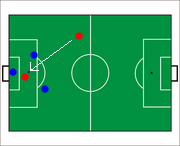
Offside situation: Red is offside
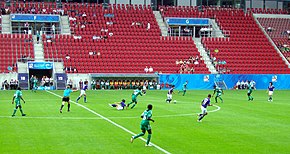
The referee (in turquoise) indicates advantage after a foul on a Japanese player (in blue) as Japan continues to possess the ball
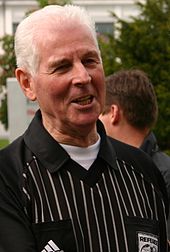
Former FIFA and World Cup referee Walter Eschweiler (2005)
.jpg)
The fourth official (here Inka Müller-Schmäh) indicates a substitution
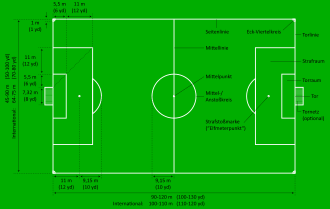
Dimensions of a football field
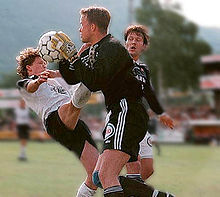
Goalkeeper
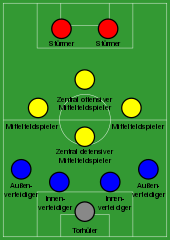
A variant of the 4-4-2 system
Questions and Answers
Q: What is the sport called in the United States, Canada and Australia?
A: In the United States, Canada and Australia, the sport is called soccer.
Q: How many players are on each team?
A: Each team has 11 players on the field.
Q: Who is allowed to touch the ball with their hands?
A: The only player who is allowed to touch the ball with their hands is the goalkeeper.
Q: How long does a match last?
A: A match lasts 90 minutes of play, with a break of 15 minutes during the match.
Q: What happens if there is still a tie after extra-time?
A: If there is still a tie after extra-time, a penalty shootout decides the winner.
Q: When does half-time occur during a match?
A: Half-time occurs during a match at 45 minutes when there is an interruption for 15 minutes.
Q: Where did modern football come from? A: Modern football came from England where The Football Association wrote standard set of rules for it in 1863.
Search within the encyclopedia